
|
|

|
|
|
|
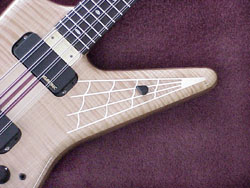
 The Spyder basses are similar to the John's personal Series II basses, but they aren't exact replicas (which would
be much more expensive). The changes we made for playability are the regular
12 inch fingerboard radius, unlike John's which were totally flat, and we moved the neck
to the bridge about a half an inch.
The Spyder basses are similar to the John's personal Series II basses, but they aren't exact replicas (which would
be much more expensive). The changes we made for playability are the regular
12 inch fingerboard radius, unlike John's which were totally flat, and we moved the neck
to the bridge about a half an inch. The body shape
gives total access to all 24 frets with complete comfort - there is nothing in the way of your fretting hand getting
to the uppermost frets. We used the same templates for the body and peghead shapes as we used on some of John's basses, and
even many of the craftspeople that made his basses still work here, still crafting as we always have.
The body shape
gives total access to all 24 frets with complete comfort - there is nothing in the way of your fretting hand getting
to the uppermost frets. We used the same templates for the body and peghead shapes as we used on some of John's basses, and
even many of the craftspeople that made his basses still work here, still crafting as we always have.
|
|
|
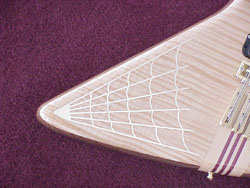

 One of the decorative details we kept from the original basses was the spider web inlays on the body. These inlays
are made from solid sterling silver and are done by hand. They run as deep as they are wide, so the amount of silver
is quite substantial. Many people thought his inlays were brass because the silver yellows over time under the finish.
One of the decorative details we kept from the original basses was the spider web inlays on the body. These inlays
are made from solid sterling silver and are done by hand. They run as deep as they are wide, so the amount of silver
is quite substantial. Many people thought his inlays were brass because the silver yellows over time under the finish. It's a good time to talk about balance. One of the things John enjoyed most about the basses we made was the
balance. The large upper body half really counters the complete lack of an upper horn for attaching the strapholder,
it also makes a fine armrest for between songs.
It's a good time to talk about balance. One of the things John enjoyed most about the basses we made was the
balance. The large upper body half really counters the complete lack of an upper horn for attaching the strapholder,
it also makes a fine armrest for between songs.
|
|
|
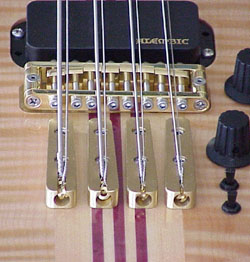
 The individual string tailpieces weigh almost twice as much as a regular single tailpiece. This extra
mass keep the strings in motion longer giving this bass some remarkable sustain properties. Each pair of strings shares
a tailpiece on the 8-string version, and each string has its own bridge saddle for intonation.
The individual string tailpieces weigh almost twice as much as a regular single tailpiece. This extra
mass keep the strings in motion longer giving this bass some remarkable sustain properties. Each pair of strings shares
a tailpiece on the 8-string version, and each string has its own bridge saddle for intonation.  For proper nostalgia we use the
"Hat" knobs on this model. We've also used the 20th Anniversary electronics for this bass. It's the closest thing you can
get to a Series I/II. These electronics use the same control layout as a Series I: 2 volumes, 2 filters, 2 Q switches,
a stereo mono switch and an on/off switch for the LEDs. For proper nostalgia we use the
"Hat" knobs on this model. We've also used the 20th Anniversary electronics for this bass. It's the closest thing you can
get to a Series I/II. These electronics use the same control layout as a Series I: 2 volumes, 2 filters, 2 Q switches,
a stereo mono switch and an on/off switch for the LEDs.
|
|
|
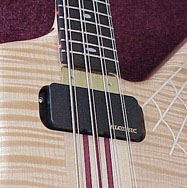
 Of course we couldn't resist installing side LED markers along the edge of the fingerboard, a classic Alembic
feature since 1970. All the stage basses we made for John had side LEDs, but now we add a small inlay of sterling silver
around each one so the marker is visible even when the LEDs are turned off.
Of course we couldn't resist installing side LED markers along the edge of the fingerboard, a classic Alembic
feature since 1970. All the stage basses we made for John had side LEDs, but now we add a small inlay of sterling silver
around each one so the marker is visible even when the LEDs are turned off.  We include a mini toggle switch
by the output jack to turn the LEDs on or off. The batteries for the LEDs are in a compartment on the upper body
half and are completely separate from the battery for the active electronics so if you should let the LED batteries
run down, it won't affect your output. We include a mini toggle switch
by the output jack to turn the LEDs on or off. The batteries for the LEDs are in a compartment on the upper body
half and are completely separate from the battery for the active electronics so if you should let the LED batteries
run down, it won't affect your output.
|
|
|

|

|

|

|

|

|
|
|
4-string peghead | 8-string peghead | LEDs | Inlay | Tailpieces | 4-string |
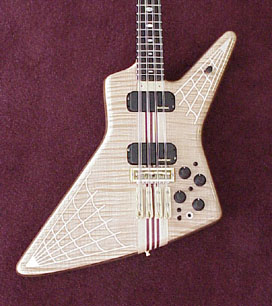
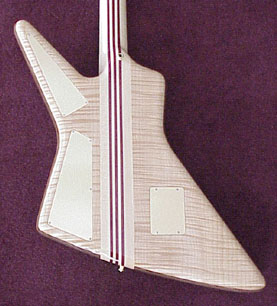
|
|
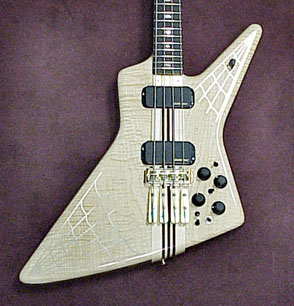
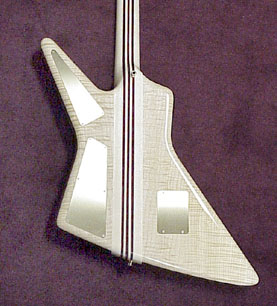
|
|
|
|
SPECIFICATIONS
Prices available on request |
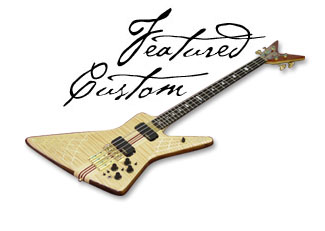
|
|
|
Custom Archive
·
Get a Custom Quote
|
|
|
The Specials · The Products · The People · The Place · The Support · Site Index |